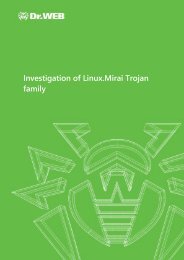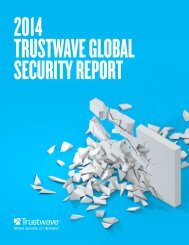y5qa5B
y5qa5B
y5qa5B
You also want an ePaper? Increase the reach of your titles
YUMPU automatically turns print PDFs into web optimized ePapers that Google loves.
ASERT Threat Intelligence Report 2016-03: The Four-Element Sword Engagement<br />
The individuals selling the exploit code at the time appear to be associated with cybercrime operations <br />
rather than APT nation-‐state targeted threats. Shortly thereafter, Sophos wrote about malicious <br />
documents appearing in the wild [8] and most of the examples they discuss appear to be related to <br />
financial threat campaigns, such as a possible exploitation campaign dealing with Point of Sale systems. <br />
Later, in December of 2015, the Microsoft Word Intruder (MWI) crimeware kit incorporated CVE-‐2015-‐<br />
1641 into its arsenal of exploit code [9]. In any event, easy access to exploit code in the underground <br />
allows targeted threat actors the means to easily and inexpensively obtain the code for their own use. <br />
In some cases in the past, dynamics of the exploit food chain has meant that exploits have migrated <br />
from advanced threat actors to cybercriminals, however they can also migrate the other direction <br />
depending upon the situation at hand. This exploit has gotten more popular and/or detected more <br />
frequently since this research was initiated started. As of March 30, 2016, 453 instances of the exploit <br />
code were detected by Virus Total. <br />
4. CVE-‐2015-‐1770: “Microsoft Office 2013 SP1 and 2013 RT SP1 allows remote attackers to execute <br />
arbitrary code via a crafted Office document, aka "Microsoft Office Uninitialized Memory Use <br />
Vulnerability" [10]. The vulnerability appears to be in an ActiveX control, according to Microsoft’s <br />
MS15-‐059 bulletin [11]. Some likely Italian-‐based exploitation activity involving the uWarrior Remote <br />
Access Trojan was observed in August of 2015 [12] using CVE-‐2015-‐1770 and other older exploit code. <br />
Other instances of exploit code have been observed, and the volume is increasing. On Feb 2, 2016 <br />
there were only 42 recognized samples of this exploit code found in Virus Total. As of March 30, the <br />
number has tripled to 128. Of the observed samples, the first submission was from August 4, 2015 and <br />
the most recent is from March 22, 2016. An exploit apparently for CVE-‐2015-‐1770 (plus CVE-‐2015-‐<br />
1650) was being sold starting in Mid September 2015 by a group calling themselves “DaVinci Coders” <br />
that allows the threat actor to embed a binary of their choice inside the Office document that will then <br />
be executed when the Office document is opened on an unpatched system. Numerous crafted RTF <br />
documents containing author metadata “Confidential Surfer” were discovered in September of 2015, <br />
and may be connected to this release. While many instances of exploit code hitting CVE-‐2015-‐1170 <br />
were discovered, underground forum chatter suggests that exploit quality may not always be top-notch.<br />
The quality or efficacy of these particular cybercrime-‐oriented exploits appears to vary, based <br />
on the number of times exploitation appeared to fail during analysis. <br />
4 Proprietary and Confidential Information of Arbor Networks, Inc.




